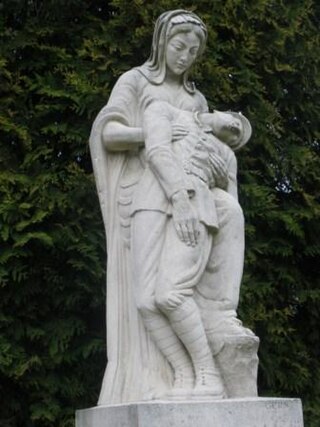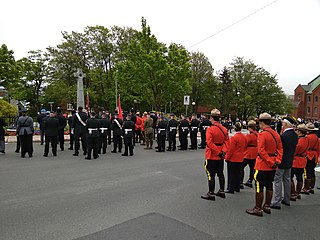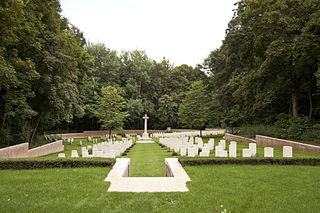
The 29th Division, known as the Incomparable Division, was an infantry division of the British Army, formed in early 1915 by combining various Regular Army units that had been acting as garrisons around the British Empire. Under the command of Major-General Aylmer Hunter-Weston, the division fought throughout the Gallipoli Campaign, including the original landing at Cape Helles. From 1916 to the end of the war the division fought on the Western Front in Belgium and France.
The Public Schools Battalions were a group of Pals battalions of the British Army during World War I. They were raised in 1914 as part of Kitchener's Army and were originally recruited exclusively from former public schoolboys. When the battalions were taken over by the British Army they became variously the 16th (Service) Battalion of the Middlesex Regiment and the 18th–21st (Service) Battalions of the Royal Fusiliers. However, Kitchener's Army was faced with a dire shortage of officers and so 'young gentlemen'— public schoolboys and university graduates, including many of those who had enlisted in the Public Schools Battalions — were encouraged to apply for commissions. The battalions' depleted ranks were made up with ordinary volunteers and although they retained the Public Schools titles, their exclusive nature was doomed. Two battalions remained to serve on the Western Front: the original battalion was all but destroyed on the first day of the Somme. After hard service both battalions were disbanded in February 1918 before the end of the war.

The Royal Newfoundland Regiment is a Primary Reserve infantry regiment of the Canadian Army. It is part of the 5th Canadian Division's 37 Canadian Brigade Group.

Beaumont-Hamel is a commune in the Somme department in Hauts-de-France in northern France.

Memorial Day has been observed annually since 1 July 1917, to recall the losses of approximately 700 soldiers of the 1st Newfoundland Regiment from the Dominion of Newfoundland at Beaumont-Hamel on the first day on the Somme during the First World War. Since the induction of Newfoundland into Canada in 1949, "Memorial Day" has been amalgamated to commemorate the war-time sacrifices of members of the armed forces of the Canadian province Newfoundland and Labrador. It is observed concurrently with Canada's national holiday, Canada Day.
Gilbert Waterhouse, was an English architect and, later, war poet. He was killed on the first day of the Battle of the Somme, in World War I, while serving as a second lieutenant in the 2nd Bn Essex Regiment. A volume of his poems, Rail-Head and other poems, was published posthumously in 1916.

The Battle of the Boar's Head was an attack on 30 June 1916 at Richebourg-l'Avoué in France, during the First World War. Troops of the 39th Division, XI Corps in the First Army of the British Expeditionary Force (BEF), advanced to capture the Boar's Head, a salient held by the German 6th Army. Two battalions of the 116th Brigade, with one battalion forming carrying parties, attacked the German front position before dawn on 30 June. The British took and held the German front line trench and the second trench for several hours, before retiring to their lines having lost 850–1,366 casualties.

The Beaumont-Hamel Newfoundland Memorial is a memorial site in France dedicated to the commemoration of Dominion of Newfoundland forces members who were killed during World War I. The 74-acre (300,000 m2) preserved battlefield park encompasses the grounds over which the Newfoundland Regiment made their unsuccessful attack on 1 July 1916 during the first day of the Battle of the Somme.

The Capture of Regina Trench was a tactical incident in 1916 during the Battle of the Somme during the First World War. Regina Trench was the Canadian name for a German trench dug along the north-facing slope of a ridge running from north-west of the village of Le Sars, south-westwards to Stuff Redoubt, close to the German fortifications at Thiepval. It was the longest such German trench on the Western Front. Attacked several times by the Canadian Corps during the Battle of the Ancre Heights, the 5th Canadian Brigade of the 2nd Canadian Division briefly controlled a section of the trench on 1 October but was repulsed by counter-attacks of the German Marine Brigade, which had been brought from the Belgian coast. On 8 October, attacks by the 1st Canadian Division and the 3rd Canadian Division on Regina Trench also failed.

The Gueudecourt Memorial is a Dominion of Newfoundland war memorial that commemorates the actions of the Royal Newfoundland Regiment during the Battle of Le Transloy, a sub-battle of the Battle of the Somme of World War I. Located about 1-kilometre (0.62 mi) north-east of Gueudecourt village, the memorial marks the spot where in October 1916, the Royal Newfoundland Regiment played a decisive role in the capture and holding of a German strong-point. The site also marks the furthest point of advance from the July 1st starting line of all British units during the Battle of the Somme.

Y Ravine Cemetery is a Commonwealth War Graves Commission burial ground for the dead of World War I situated on the grounds of Beaumont Hamel Newfoundland Memorial Park near the French town of Beaumont-Hamel.

Hunter's Cemetery is a Commonwealth War Graves Commission burial ground for the dead of World War I situated on the grounds of Beaumont Hamel Newfoundland Memorial Park near the French town of Beaumont-Hamel.
Serre-lès-Puisieux is a village in the commune of Puisieux in the Pas-de-Calais department in Hauts-de-France in northern France.

The Capture of Beaumont-Hamel was a tactical incident that took place during the Battle of the Somme in the Battle of the Ancre (13–18 November) during the second British attempt to take the village. Beaumont-Hamel is a commune in the Somme department of Picardy in northern France. The village had been attacked on 1 July, the First Day of the Somme. The German 2nd Army defeated the attack, inflicting many British and Newfoundland Regiment casualties.

The Ancre British Cemetery is a cemetery located in the Somme region of France commemorating British and Commonwealth soldiers who fought in the Battle of the Somme in World War I. The cemetery contains mainly those who died on 1 July 1916 during the first Allied attack on the village of Beaumont-Hamel, on 3 September 1916 during the second Allied attack on the village, and on 13 November 1916 during the capture of the village and the nearby towns of Beaucourt-sur-Ancre and St. Pierre-Divion.

The Aveluy Wood Cemetery is a cemetery located in the Somme region of France commemorating British and Commonwealth soldiers who fought in the Battle of the Somme in World War I. The cemetery honors mainly those who died on the front near Aveluy Wood and the village of Aveluy from June 1916 to February 1917 and from April to September 1918.

The Bapaume Post Military Cemetery is a cemetery located in the Somme region of France commemorating British and Commonwealth soldiers who fought in the Battle of the Somme in World War I. The cemetery is also known colloquially as the Tara Hill Cemetery and the Usna Hill Cemetery.

The Bécourt Military Cemetery is a cemetery located in the Somme region of France commemorating British and Commonwealth soldiers who fought in the Battle of the Somme in World War I. The cemetery contains those who died in a variety of dates from August 1915 to April 1917 manning the front line near the village of Becordel-Becourt and is managed by the Commonwealth War Graves Commission.

The Bernafay Wood British Cemetery is a cemetery located in the Somme region of France commemorating British and Commonwealth soldiers who fought in the Battle of the Somme and against the German 1918 spring offensive in World War I. The cemetery contains mostly those who died between July 1916 and April 1917 and March–August 1918.

The Bouzincourt Communal Cemetery Extension is a cemetery located in the Somme region of France commemorating British and Commonwealth soldiers who fought in the Battle of the Somme in World War I. The cemetery contains mostly those who died between May 1916 and February 1917 and between March and September 1918 on the front line near the village of Bouzincourt. The cemetery is managed by the Commonwealth War Graves Commission.

















